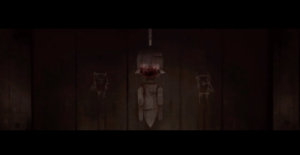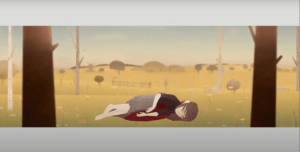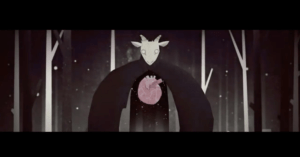NOTE: This entry contains spoilers for Year Walk.
This week, I sat down to play Year Walk, an eerie puzzle game developed and published by Simogo. The game is available on Steam, Wii U, and iOS—where I played it. Marking a serious tone shift from games I have previously played for the class, Year Walk’s chilling visuals and grim narrative make it an experience more fit for mature audiences. The game itself is relatively light on instruction, dropping the player in the middle of a snowy forest with puzzles scattered throughout. At the same time, the game comes with a companion encyclopedia, which provides useful context for the game and even holds the key to understanding the central narrative of the game. Overall, Year Walk’s enigmatic setting and relatively sparse instruction pair with a rich companion encyclopedia app to create a narrative that the player must immerse themselves in to solve. This dynamic, combined with an ending which reveals a potential time loop, adds immense replayability to the game.
We start first with the architecture of the game’s setting, which is a snowy forest filled with creatures from Swedish folklore. The aesthetics of the forest make it feel much like a picture book, with simple illustrations that contribute to the folklore context. In contrast to many games where the main objective is exploration (e.g. What Remains of Edith Finch, Firewatch, etc.), Year Walk introduces a very unique mechanic for navigating the world. Movement in one axis is achieved through scrolling, while walking forwards or backwards is done through swiping through layers. In introducing this movement mechanic, as well as declining to add a map of the forest, the developers are able to effectively create a dynamic where the player feels lost. Being unable to see behind me, I found it very hard to keep track of where I was. From a design standpoint, this is a powerful tool, as it helps immerse the player in the world of the protagonist, who is also lost in the woods.



The visual aesthetics of the game, though simple, created a lingering sense of eerie-ness.
At the same time, as I got more comfortable with this system, I found myself scrolling and swiping relatively fast, which took me out of the game somewhat. To some extent, this was a negative consequence of this navigation mechanic, as I didn’t have to slow down and savor the scenery like I did in What Remains of Edith Finch. And yet, I believe this mechanic of quick navigation also serves the replayability of the game, since I know I could get through it much faster the second time.
While Year Walk’s developers are able to achieve an immersive experience with their minimalist gameplay (no menus, almost no UI, and little text), they also provide much needed context through a companion encyclopedia app. This additional resource, which I found to be one of the most fascinating parts of the game, adds additional information while retaining the sense of immersion. At the end of the game, the player must coordinate information from both apps in order to unlock the final ending. From a design perspective, this puts a detective hat on the player, requiring them to piece together information from different areas of the gaming experience in order to solve the puzzle. This simple mechanic makes reaching the end of the game that much more rewarding for the player, who gains access to a brief epistolary story and reaches their own understanding of the game’s events.

The companion app held my hand through the more obscure folklore elements, like the Church Grim.
In addition to the immersive mechanics listed above, Year Walk also uses its narrative element of time to introduce a loop, which adds to the replayability of the game. In the end, we discover that the protagonist we have been playing as will murder his companion. However, we are told that we can prevent this if we take another Year Walk. The game ends with the simple question: “walk again?” Admittedly, having just played the game, I was tempted to play it again, now having much more context for what was happening. All in all, this immersive experience and loop makes the game very tempting to replay and enjoy time and time again.





